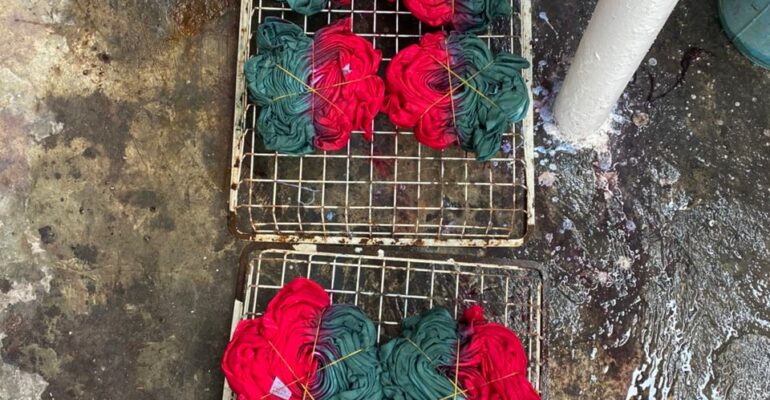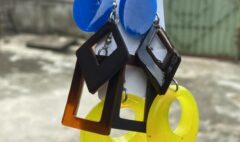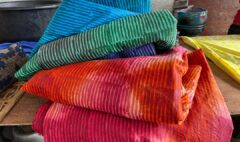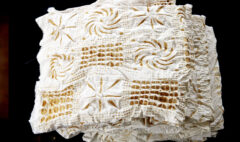The Art of Tie & Dye: Step-by-Step Guide to Creativity and Profit
The Art of Tie & Dye: Step-by-Step Guide to Creativity and Profit
The Art of Tie & Dye: Step-by-Step Guide to Creativity and Profit
Introduction: Why Tie & Dye Is More Than Just Fashion
Tie and dye is a language. It tells stories of rivers and resistance, of markets and migration, of textures that traveled from Abeokuta to Accra, from Kano to Kingston, and from Dakar to Detroit. It is not only a trend for festivals and summer lookbooks. It is a craft with centuries of African intelligence behind it. Think of Yoruba adire, the ancient indigo pits of Kofar Mata in Kano, or the dye traditions that stretched across the Sahel. Colonial trade tried to break local textile economies with imported machine cloth. African dyers responded with design, with chemistry, with community networks. That is the political economy of color.
Unlike beadwork or leather tooling we might explore in other crafts, tie and dye asks for choreography and chemistry in the same breath. You fold, tie, soak, stir, then step aside and let color bond to fiber. The results can be artisanal or avant garde, homegrown or haute couture. And with the right plan, it can be a steady business that respects heritage while paying the bills.
A Human Story: Aisha of Abeokuta and the Cloth That Would Not Fade
Aisha grew up two streets from Itoku market in Abeokuta. Her grandmother sold adire oniko, patterns guided by raffia knots and patient fingers. One evening, Aisha brought home a T-shirt order for a local dance crew. Their budget was thin, their timeline thinner. She resisted the cheap dyes in the corner shop and found fiber-reactive powders in a friend’s studio. She scoured the shirts, mixed soda ash, tied sunbursts with jute, and waited through the humid night.
In the morning, the sink ran blue, then pale, then clear. The shirts kept their color. At the performance, the dancers moved like a single spiral unspooling. New orders followed, then an invite to a pop-up in Lagos, then wholesale inquiries from Nairobi. When her grandmother saw the Instagram video, she laughed. The cloth would not fade, she said. That is the point of learning the old ways deeply, then choosing your own road.
Tools and Materials Needed
- 100 percent natural fiber fabrics, cotton or rayon are best. Silk works with acid dyes, wool is uncommon for tropical wear.
- Dyes, fiber-reactive dyes for cellulose fibers, for example Procion MX type. Natural indigo is an option if you can maintain a vat.
- Fixative chemistry for fiber-reactive dyes, soda ash, also called sodium carbonate. For acid dyes on silk, white vinegar or citric acid.
- Urea to help dyes dissolve and stay moist on fabric. Optional but useful in dry climates.
- Salt for some dye systems. Not needed for most fiber-reactive low water immersion methods.
- Thickener for painting or printing, sodium alginate.
- Detergent for scouring and post-wash, a neutral detergent or Synthrapol.
- Buckets or plastic tubs, measuring spoons, a digital scale for accuracy.
- Squeeze bottles, foam brushes, or syringes for application.
- Rubber bands, string, raffia, marbles, clamps, chopsticks, PVC pipe for arashi pleats.
- Protective gear, gloves, apron, mask, goggles. Work in a ventilated area.
- Drying rack, plastic sheeting, and zip bags to keep fabric damp while dye bonds.
- For natural indigo, a reduction agent such as fructose or henna, a non-metallic vat, pH strips.

Safety first. Wear gloves, avoid inhaling dry powders, do not dump strong chemicals into drains. Neutralize bleach effluent with sodium thiosulfate. Keep food separate from dye areas.
Step 1: Preparing the Fabric
- Prewash to remove sizing. Wash the fabric with hot water and a small amount of detergent. For cotton, add washing soda to scour if the fabric feels waxy.
- Soak in soda ash solution, about 1 cup per 4 liters of warm water, for 15 to 30 minutes when using fiber-reactive dyes. Wring out until damp, not dripping.
- For natural indigo, skip soda ash. Your vat pH will be managed separately. Prewet the fabric in clean water so the indigo penetrates evenly.
The quality of this step decides colorfastness. Skipping it usually leads to dull color or heavy washout.
Step 2: Tying Techniques, Spiral, Stripes, Sunburst, and More
- Spiral. Pinch the center, twist in a flat circle, keep turning until you form a disc. Secure with three to six rubber bands crossing the disc like a pizza.
- Stripes. Accordion fold the fabric along the width for horizontal stripes or along the length for vertical stripes. Clamp with popsicle sticks or bind tightly with string to create resist lines.
- Sunburst. Pinch small points across the fabric, wrap with string a few times to create little rings. Add marbles for pronounced orbs.
- Arashi pleats. Wrap the fabric diagonally around a PVC pipe, scrunch tightly, bind with string. This gives rain-like diagonal patterns.
- Yoruba inspired oniko. Use raffia to tie rice grains or small pebbles into the cloth. The raffia resists dye sharply and nods to classic adire methods.
- Stitch resist. Hand stitch running lines with strong thread, pull tight to gather, then dye. Unpick after fixing to reveal precise motifs.
Tie with intent. Loose ties give soft halos, tight ties give crisp edges. Mix techniques across a single piece to move from chaos to control.
Step 3: Mixing and Applying the Dyes
- Measure, do not guess. For strong colors on cotton, a common starting point is 10 to 20 grams of dye powder per liter of water, adjusted to brand instructions.
- Dissolve. Mix dye paste in a small cup with warm water, then extend to your working volume. Add urea if your climate is dry to keep the fabric moist longer. Add alginate if you plan to paint motifs.
- Apply. Use squeeze bottles for precise lines, brushes for washes, or dip for overall tones. Turn the piece as you work so color penetrates folds.
- Batch. Wrap the dyed fabric in plastic or place it in zip bags. Keep it warm and damp for 8 to 24 hours. Fiber-reactive dyes need time for covalent bonding with cellulose.
- Natural indigo. Dip briefly, 30 seconds to 2 minutes per dip. Expose to air and watch the green turn to blue as it oxidizes. Repeat dip and oxidize until you achieve depth of shade.
Color layering is powerful. Apply light colors first, then dark. Remember color theory. Yellow under blue gives green. Red near blue gives a bruise of purple.
Step 4: Rinsing, Drying, and Fixing the Colors
- Rinse cold until water runs nearly clear. Remove ties carefully to preserve pattern integrity.
- Wash warm with a small amount of detergent to remove unattached dye. For cotton with fiber-reactiv

e dyes, this step locks in brilliance.
- For silk dyed with acid dyes, rinse gently and add a vinegar bath if required by your dye system.
- Air dry in shade. Direct sun can shift hues while wet. Press with a warm iron once dry to smooth fibers before tagging or selling.
If a customer can wash your piece at home without color bleeding, you have done the job right.
Creative Variations: Patterns and Modern Twists
- Ice dyeing. Place dry soda-ash-soaked fabric on a rack, cover with ice, sprinkle powdered dye. The melt creates watercolor veining.
- Reverse dye on dark cotton. Use a controlled bleach solution to remove color, then overdye. Neutralize thoroughly with thiosulfate to stop fiber damage.
- Screen or stencil overlays. Print a logo, proverb, or Adinkra symbol using alginate-thickened dye after your base tie pattern.
- Discharge on indigo. Discharge paste or a mild reducing agent can draw motifs out of deep blue fields.
- Hybrid with batik. Wax out motifs, tie some sections, then dye in layers. Remove wax, then add a final light dip for subtle depth.
Innovation matters, but so does respect. Credit the communities that built these techniques. When you remix, tell that story as part of your brand.
How to Turn Your Tie & Dye Into a Business
- Start lean. A basic setup can happen on a patio. Tubs, gloves, racks, simple measuring tools, a few colors, and a small inventory of cotton blanks.
- Build a signature. Three or four repeatable patterns, a seasonal palette, and a label that reflects your roots. Customers return for consistency.
- Document your process. Short videos, before and after shots, and atelier notes. This is proof of craft and a magnet for buyers.
- Quality control. Keep swatch books with formula notes. Test wash each batch. Reject pieces that bleed or smell of residual chemicals.
- Sourcing. Partner with local weavers for base cloth where possible. For blanks, prioritize certified cotton and transparent supply chains.
- Sustainability. Reuse rinse water for first washes when safe, keep a separate neutralization bucket for bleach, and plan small-batch production to reduce waste.
Regulatory basics matter if you plan to export. Label fiber content and care instructions. Research tariff and HS codes for your product category. Keep invoices and batch records.
Pricing, Marketing, and Selling Online and Offline
Costing example for a premium T-shirt:
- Blank cotton T-shirt, 3.00 USD
- Dyes and chemicals, 1.20 USD
- Utilities and water, 0.50 USD
- Labor, 45 minutes at 4.00 USD per hour, 3.00 USD
- Packaging and tag, 0.30 USD
- Overhead allocation, 0.70 USD
Total cost, 8.70 USD
Set target margins with intent:
- Retail target margin 60 percent. Price equals cost divided by 1 minus margin. 8.70 divided by 0.40 gives 21.75 USD recommended retail.
- Wholesale target margin 30 to 40 percent for you. Offer at 12.50 to 14.50 USD to vetted stockists with minimum order quantities.
Tier your range. Entry items like bandanas or tote bags bring volume. Hero pieces command higher prices. Keep limited editions to maintain desirability.
Marketing playbook:
- Visual storytelling. Show the twist, the dip, the reveal. Post reels at 9:16 for mobile. Use natural light and clean backgrounds.
- Cultural narrative. Share the link between your techniques and West African resist traditions. Name patterns with meaning, like Oke Ona spiral or Kofar Mata stripe.
- Platform mix. Instagram and TikTok for awareness, WhatsApp Business for conversion, Shopify or Ecwid for storefront, Ets

y for global discovery. In many African markets, Jumia, Konga, Takealot, and TikTok Shop drive orders.
- Payment and logistics. Offer M-Pesa, Flutterwave, Paystack, and card options. Use size charts. Include care cards. Roll garments with tissue to reduce creases. Add silica gel in transit during rainy seasons.
- Offline sales. Craft fairs, campus pop-ups, hotel boutiques, cultural festivals, and curated markets like Lekki Arts and Crafts Market in Lagos or Maasai Market in Nairobi. Bring a mirror, a portable steamer, and a card reader.
Partnerships win. Collaborate with photographers, dancers, or poets. Limited runs for a music video or gallery opening can catalyze word of mouth.
Field Note: Markets, Power, and Color
In the 1920s, adire boomed in Abeokuta as imported European shirting became the new canvas. Women dyers organized production, managed apprentices, and ran stalls that fed entire families. Then came the slump of the 1930s. Cheaper synthetic dyes faded, global demand dipped, and colonial policies favored imported prints. Yet the craft did not die. It adapted, migrated, resurfaced in festivals and ateliers, and later fed global fashion cycles when tie and dye exploded in the 1960s. The lesson is alive today. Control quality. Tell your story. Build networks that outlast trends.
Conclusion: Building a Sustainable Artistic Brand
Tie and dye is technique, but it is also testimony. When you price with clarity, source responsibly, give credit to lineages, and invest in repeatable quality, you move from hobbyist to heritage maker. Keep a lab notebook, but also keep a listening ear to elders and archives. Refuse extractive shortcuts. Protect your hands and your margins.
What pattern will you claim as your signature, and what community will benefit when your colors find the world?
Selected Sources and Further Reading
- Aronson, Lisa. “The Language of Adire.” African Arts, Vol. 25, No. 2, 1992.
- Byfield, Judith A. The Great Upheaval, Women and Nation in Nigeria, 1900 to 1960. Ohio University Press, 2002.
- British Museum Collection Online, Adire textiles from Abeokuta, object notes and provenance entries.
- Smithsonian Center for Folklife and Cultural Heritage, articles on indigo traditions in West Africa.
- UNCTAD, Creative Economy Outlook 2022, data on global creative goods trade.
- International Labour Organization, Decent work in the cultural and creative sectors, policy brief series.
- National Commission for Museums and Monuments Nigeria, documentation on Kofar Mata dye pits, Kano.
Continue.










